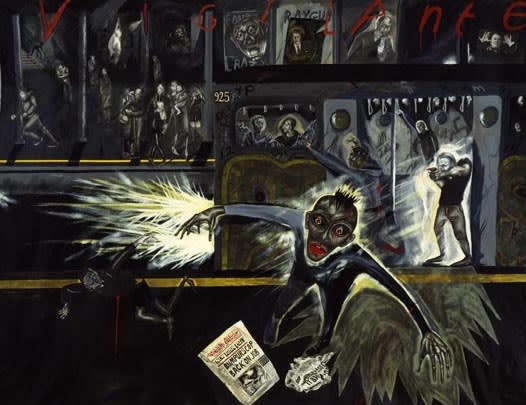Coe’s pained and painful subjects range (or don’t range) from apartheid to rape and abortion, from vivisection to vigilantes, from cop brutality to the Greenham women and nuclear fire storms. So what else is new in the East Village? What’s rare is Coe’s ability to transcend emotionally and pictorially the gutter chic underlying the mainstream. Her work is not ironic and it’s not funny. Coe is mad as hell. She hates Raygun and the rich and the cops and the royals. As outrageous as she is outraged, she made a painting called England is a Bitch during the 1981 London riots: “Rupert Murdoch, the Prince of Darkness, wasn’t covering the riots at all,” she says. “It was the mating rituals of the royal family. So I decided to do a picture of Princess Di giving Prince Charles a blowjob at the same time as the riots. When I did this painting, they said I had no taste. It was vulgar. But I think the royal family is vulgar, and I think they should be executed in classical style.”
If Rupert is the Prince, then Sue is the Princess of Darkness. Restaging the allegorical tensions of Bosch or Beckmann in a greasy, violent 42nd Street setting, she is an anomaly here because her work is a conscious part of a class struggle usually invisible in America’s art – with few exceptions, such as May Stevens, Tim Rollins, Jerry Kearns or Juan Sanchez. Despite the underclass sources of all the camp and kitsch and borrowed brass that permeates the art of the ‘80s, even the graffiti artists who are the prime transmitters of those sources ignore the issue of class.
Coe is one of several more and less successful artists (like Barbara Kruger and Seth Tobocman) who cross over and back from fine art to commercial art. Along with those who imitate the commercial look, they are partially responsible for what I call the “journalization” of current art. They have learned to communicate directly, in black and white; they don’t see commercial art as merely a way to make a living, but as a respectable form of activism. “It can be bought and seen cheaply,” says Coe. “I consider selling out more like going into the gallery situation. There I don’t feel too clean…[But] I do a commodity art object because I love painting, I love drawing. They’re not going to deny that from me.”
She is equally sold on her independent mass-reproductive rights, and is pleased that her book, How to Commit Suicide in South Africa (with Holly Metz), is used as an organizing tool. “I don’t want my work just to shake people up.” Coe’s drawings can be seen often on the Times’s op ed page and reproductions are sold cheap through Mother Jones. Her new book on war resisters includes interviews with “graffiti artists” who, like the Ploughshares 8, spray weapons instead of walls. “If you spray on a weapon, you get two years. If you spray on a wall you get in Art News” (or you get two days in jail, a heavy fine, or killed like Michael Stewart).
Moral earnestness and political slogans are not most gallerygoers’ cups of tea, even in these days of whine and grossness. But Coe’s barrage of gaunt and screaming faces, flailing limbs, and pools of blood appeals both to the committed and to the noncommittal. Maybe her popularity is a symptom of mercantile masochism: Buy off the brush that bites you. Maybe she gets over for the same reason that Jaws and Halloween rated sequels. If you see it happen to someone else, you’re immune. Maybe, but it’s more likely that she is successful because she’s true to her raw obsessions. These have been her subjects since she was ‘….a kid in school. It was my reality and the reality I grew up in, and it still is what I see.”
Excerpted from original article. Quotations from Upfront, No. 9, 1984.
